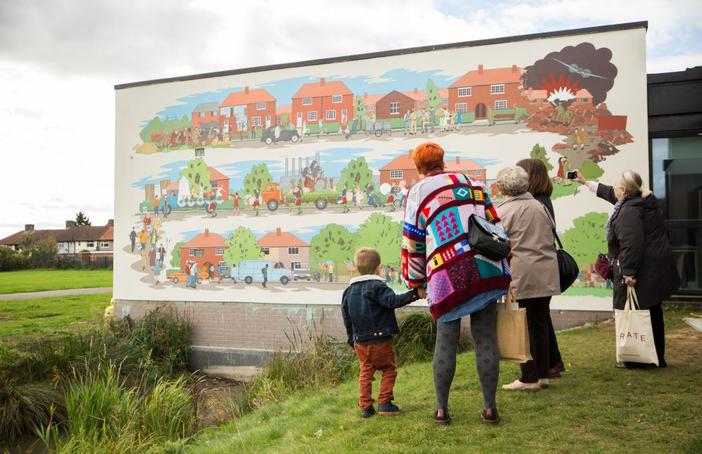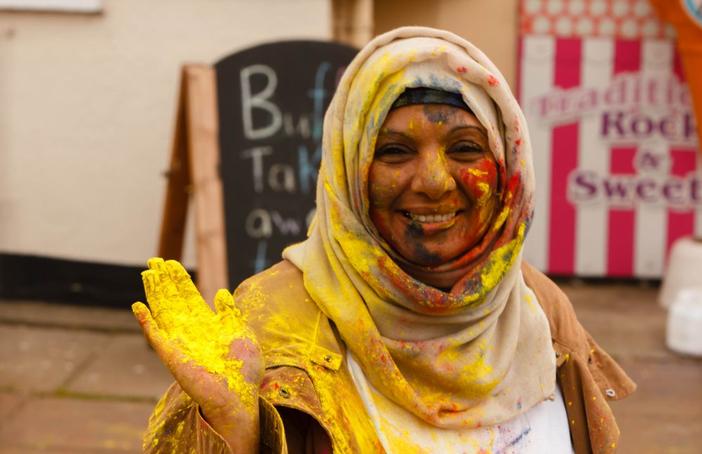Blog Post
Cultural connectors at the heart of community commissioning
Holly Donagh and Farida Mohamed from Creative Barking & Dagenham describe how Cultural Connectors - a group of over 100 local people - are in the driving seat of the programme

The last time I was in Barking library, I met a painter who’d been given a small cupboard-like area to work in, he had his canvasses up and was painting beautiful portraits in oils, I then went to have a look at the sauna and treatment room (tucked behind the crime section) a wonderful calm space with art on the walls from an exhibition instigated by Creative Barking and Dagenham (CBD)a few weeks earlier. The owner told me what a privilege it was to be able to connect with interesting people through the CBD network and tried to persuade me to come back for reiki massage.
Outside the library, I walked round the corner to see the new Abbey leisure centre, a stunning, sleek space right in the heart of the town – as you get up close you can see (and there really is no easy way to describe this) a towering doll-like figure known as the Icon made of black and white fabric. This is the new soft-play structure designed by the artist Martyn Gaye-Chetwynd. Inside music blares and toddlers swing off the icon’s arms. This was all within fifteen minutes of leaving the train station.
When I first came to Barking and Dagenham, a large borough on the east-side of London, to help develop the Creative People and Places bid, people said to me that residents never got involved in civic programmes, and would never want to do arts projects. I wonder if anyone would say that now?
My previous visit to the Borough had been to the unveiling of the This used to be fields mural at the park next to Valance house, a parcel of flat green land in the middle of the Becontree estate. It was one of the happiest art gatherings I have ever taken part in, residents from the estate explained the mural to me (the little stories and hidden histories Chad McCail - aided by History Pin - had so expertly inserted) and when it came to the speeches Chad was overwhelmed with gifts from residents and given a truly emotional farewell to his time in the borough. Again, this did not seem like a place where people were not interested in art and did not want to get involved with things.
I think CBD has managed to tap into something really special in the borough and find a way of giving people a licence to be creative, to have a bit of fun and to start to express some pride in their place and optimism about the future. As a Board member for CBD I guess I am biased but I don’t think I am wrong.
Perhaps the most effective strategy has been to put residents in the driving seat of the programme. 104 Cultural Connectors have joined the programme since the beginning. They are people from the borough who have found their way to the programme (or been found by the programme) and who spread the word about what CBD is doing to their friends and family, they can also tell us what they need and how they want the creativity of the borough to develop. Far from being the usual suspects they are a multifarious groups – all ages, races and crucially very different histories of engagement with the arts. They are not ‘representative’ of anything but themselves but they do hold some kind of spirit or energy of the place which is slowly uncovering the idiosyncratic creativity of the borough.
The Connectors play a key role in all our commissioning. I sat on the last commissioning panel as an observer with four connectors and two external artistic advisors. The panel made decisions about the next major tranche of CBD funding known as Landmark funding.
"Being on the panel and listening to everyone’s opinions helps a lot, we talk first to decide what we want as an outcome and that way we don’t just get swayed by a nice project idea. The panel reminds us all the time what are looking for and you don’t get distracted from this, which helps us make the right choice.
"Personally I think I’m very bad at interviews, and being on a panel to see how it works, the criteria and how people decide, is important for me because I wanted to see the other side of interview techniques.
"And it was great to be able to discuss everything with the variety of people that are in the room at the panel.
"I think that CBD has created awareness of art, but in a fun way and now it feels to me at least, like everyone is talking about it. Especially now with the summer festivals coming up, it feels like a new kind of friendly club and everyone wants to be part of it.
"I am enjoying being part of the CBD Network. It’s amazing, it’s like a big family and it’s wonderful. What has happened here, in the three years since I have lived here, there’s been lots of change and it’s incredible." Farida Mohamed, Cultural Connector
The perceived risk of giving residents this much power is that they will choose ‘safe’ work, that they will not know ‘quality’ when they see it and they will be swayed by a smooth-talker. I can safely say none of these things were true of my panel and in truth these concerns say more about the art establishment’s desire to keep the levers of power to itself than anything else.
It is quite something to see a resident quiz an arts professional on their approach to community engagement, there can be no hiding in rhetoric, or re-hashing of approaches from past projects, respondents have to be clear, genuine and committed in order to sound credible. I have never seen seasoned arts professionals sweat so much as when being posed these type of questions by our one our connectors.
It was useful to have external arts advisors as part of the panel especially to provide more context about particular proposals and as a check against group-think but it was really the Connectors who had the strongest instincts for what would work. A couple of the proposals were deeply conceptual in their approach and what might be considered ‘challenging work’, the panel were not intimidated by this and quite able to give them a fair run within the process. Though I would say that, perhaps understandably given the sums of money involved and the relative lack of investment in the Borough, the Connectors were more interested in a sense of legacy, permanence and lasting impact than the rest of the group and this sparked a really interesting discussion.
Connectors picked some truly fabulous projects in the last round (not only the wonderful Chad McCail, but Harald Smykla in Barking Market and People Palace Project’s Becontree Hundred) and I am sure the commissions for 2015-2016 will also exceed our expectations.
One of the first new commissions will be Gerry Pilgrim at the ex-Sanofi factory in Dagenham. I hope to see you there.
This summer CBD is putting on an exciting programme of festivals in Dagenham Village, Parsloes Park and Barking Riverside starting with DagFest on Saturday 11 July. The programme has been developed and curated by Cultural Connectors with support from artistic advisors Maggie Clarke from Xtrax and Bradley Hemmings from Greenwich + Docklands International Festival. Come along and join us...

Cultural Connector Farida Mohamed. Photo: JayBright Photography







